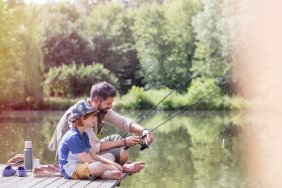 Soft plastics come in a variety of shapes and sizes to suit a number of situations on the water. Worms are great when a slow, calculating approach is necessary, while jerkbaits can be worked through the water rapidly to locate fish and entice reaction strikes on the move. Another great plastic lure that every serious angler should keep in their tackle box is the beaver bait. These little beauties work magic when flipped and pitched, and today we’ll take a closer look at how to use them to put more fish in the boat this season.
Soft plastics come in a variety of shapes and sizes to suit a number of situations on the water. Worms are great when a slow, calculating approach is necessary, while jerkbaits can be worked through the water rapidly to locate fish and entice reaction strikes on the move. Another great plastic lure that every serious angler should keep in their tackle box is the beaver bait. These little beauties work magic when flipped and pitched, and today we’ll take a closer look at how to use them to put more fish in the boat this season.
There are several reasons for the beaver’s effectiveness. For starters, it offers a streamlined and compact profile, which makes it look vulnerable—and thus, more appealing—to bass. This body design also does a great job of resembling both crawfish and shad—depending on the way it’s worked—with an erratic action.
There are a number of ways that you can fish a beaver bait. A popular method is Texas rigging. The bait excels when rigged this way because it will dart from side to side and fall erratically when you pitch it into bushes or around timber. Like a jig, all you have to do is give it a hop and wait a few seconds or so in between before repeating. The bait does all the work for you. With a Texas rig, it helps to use the biggest hook you can get away with because you will be hooking into some pretty big fish, and you’ll need the big hook to handle the fight. Usually, a 5/0 hook will work wonders, and in fact, the heavier weight will get you more bites. While flipping and pitching a beaver is deadly for big bass, another great way to fish it is with a drop shot rig. When you get around boat docks and other vertical structure, a drop shot rigged beaver can really pull in big numbers of fish. The bait’s size and body style provide a little different action than fish are used to and it also offers a larger profile for them to hone in on.
You’ll want to go with a stiffer fishing rod and strong line when fishing a beaver, such as a 7’ medium-heavy rod with a tip that’s a little sensitive. The softer tip will allow you to feel sneaky bites, but the strong backbone will help pull fish out of heavy cover. If you have a setup for flipping, it’s best to just tie a beaver on to that combo and go to work. Since you’ll be working in and around grass or wood, line in the 20-lb range, or braid, is the way to go.
I’ve met many anglers who swear by the beaver bait, and I’ve had a ton of luck with it myself throughout my years on the water. Soft plastics have amazing action in the water and with the variety of beaver styles available today, you’ll have a blast experimenting and pulling in fish while you do so.








